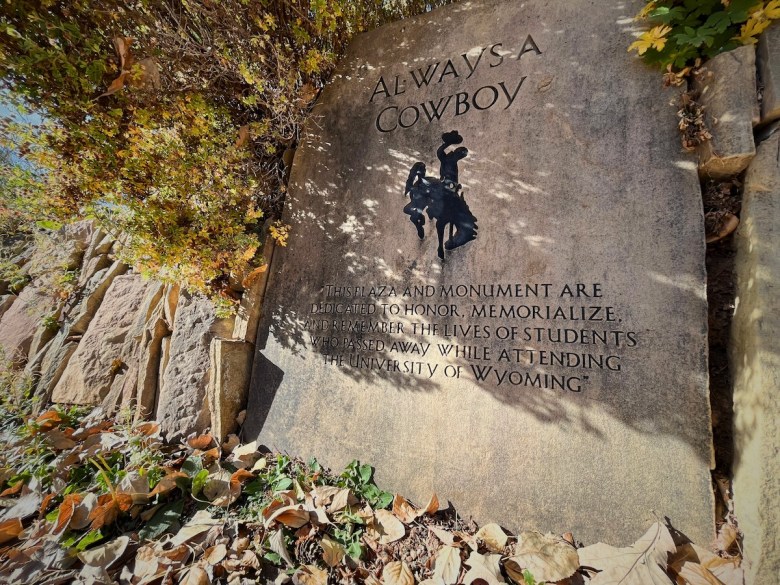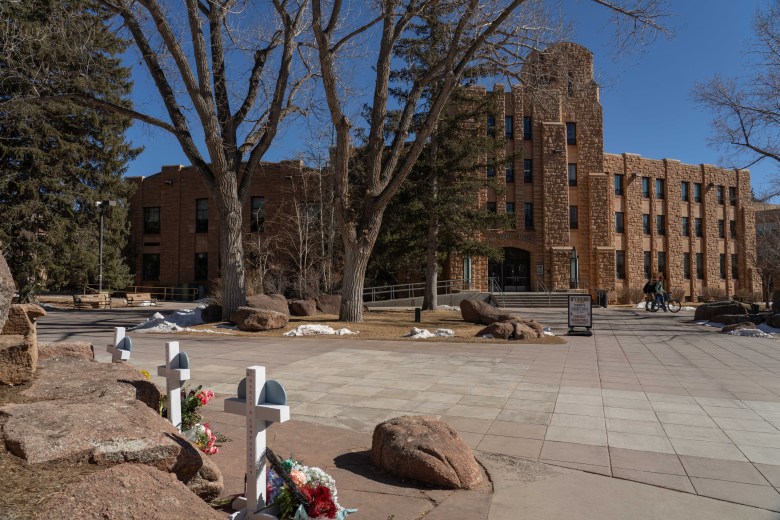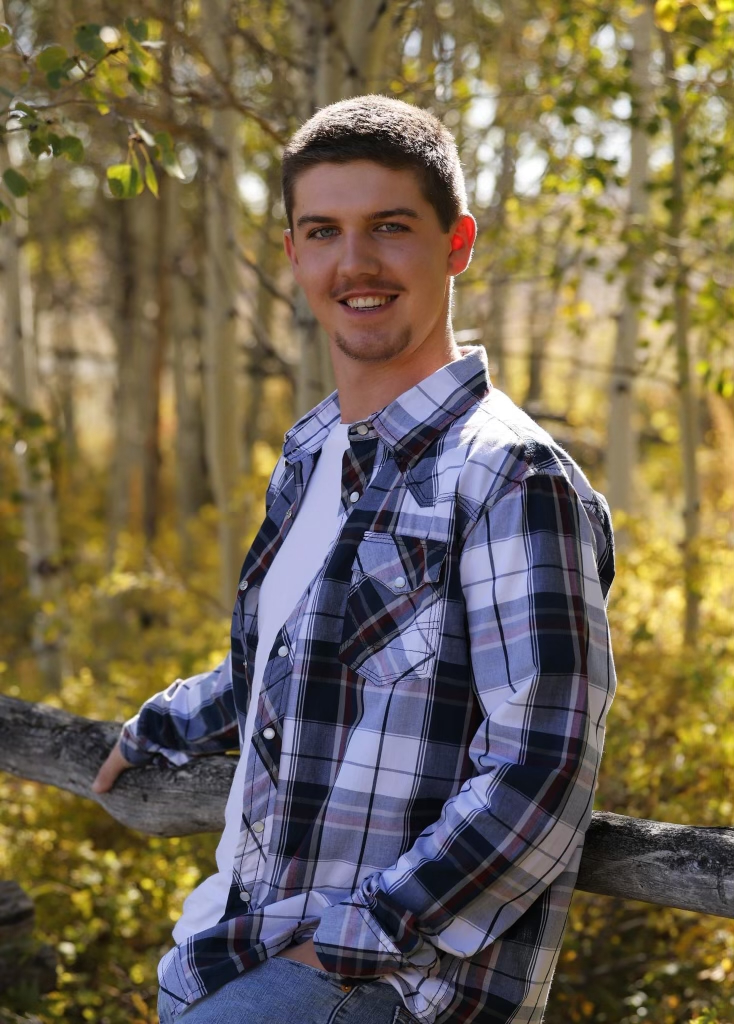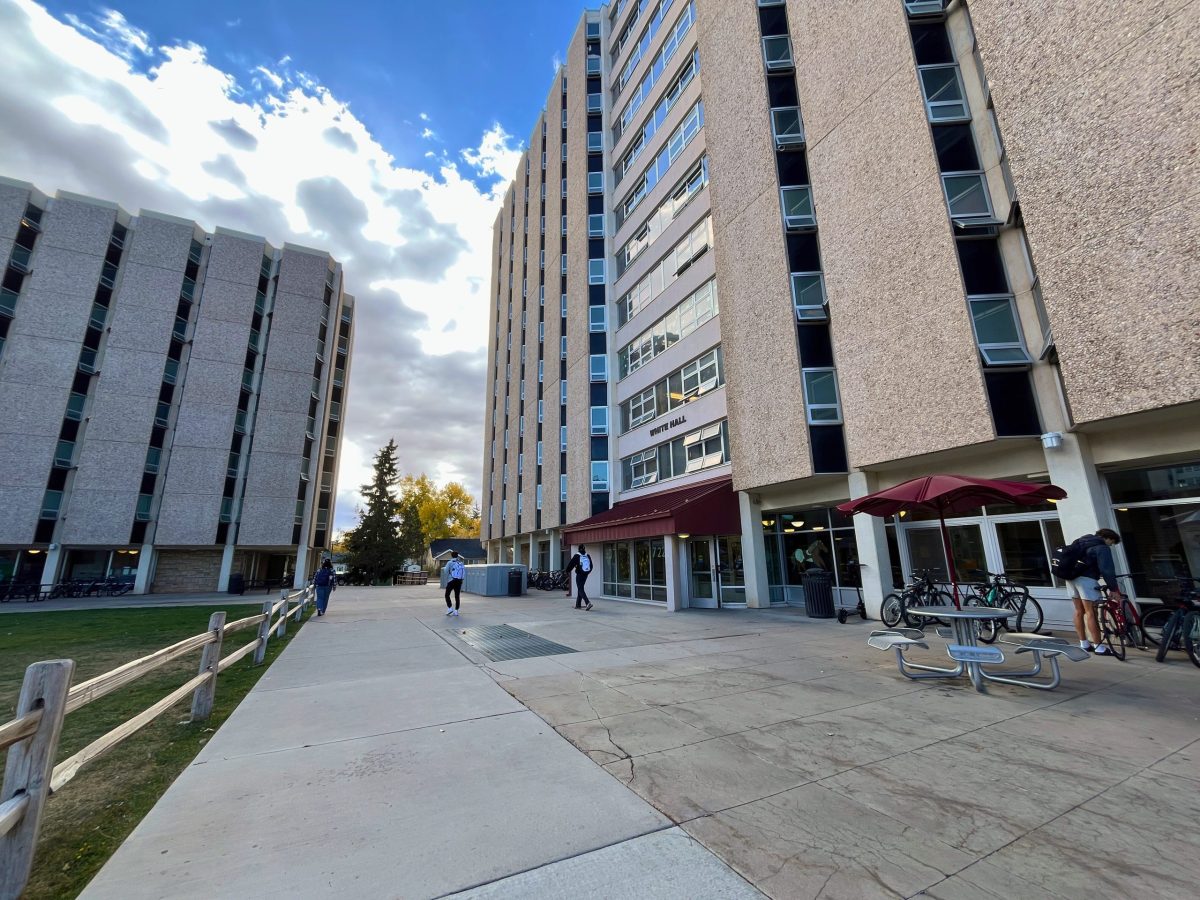This story discusses suicide. If you or someone you know is having suicidal thoughts, call or text the Suicide and Crisis Lifeline at 988.
They packed the pews tight at Saints Cyril and Methodius Catholic Church, those without seats standing wherever they could find space. Mourners took off work and school, many traveling across Wyoming to gather on a calm, sunny October morning in Rock Springs. The service started late in order to make room for everyone.
This was the funeral of Dawson Fantin, an 18-year-old graduate of Rock Springs High School who’d only recently left his hometown to start college at the University of Wyoming on a prestigious Trustees’ Scholar Award. One month into the semester, he died in his dorm room of an apparent suicide. The Sept. 28 death remains under investigation pending the results of an autopsy and toxicology screening.
But there in the church, family and friends celebrated a young man who embraced people from all walks of life. He also had a competitive side, representing Wyoming in national high school speech and debate competitions. He volunteered at the local senior center and throughout the community. He lit up rooms with his goofy sense of humor. He was open about his own struggles with PTSD as part of his advocacy to destigmatize mental health care. His death shocked family and friends who saw nothing but his bright future ahead.
The University of Wyoming, in contrast to the outpouring of grief in Rock Springs, marked his death with nearly three weeks of silence. It wasn’t until Oct. 18 — 20 days after Dawson’s passing and 10 days after his funeral — that UW sent an email to the campus acknowledging a student had died.
But that decision spurred suspicion about why UW had kept quiet.
Effective communication
Dawson’s parents, Debra and Paul Fantin, grew concerned about the delayed communications after hearing from Dawson’s friends that the burden of sharing the heartbreaking news with their professors was falling to them, and not the university.
When asked why UW waited 20 days to notify staff and students of Dawson’s death, Vice President of Student Affairs Kim Chestnut told WyoFile the university was following outdated guidelines that advised against public notifications to prevent further suicides through contagion. Instead of an all-campus message, Chestnut said, a team had been working to reach out directly to impacted students and faculty. The university changed course, sending out the Oct. 18 email, when it came to light the guidelines had changed, Chestnut said.
“What I would offer is we have a new director of our counseling center,” Chestnut explained. “So Megan Belville [had] just begun in that position at the start of this academic year, and she researched last week what the practice recommendations are with the growth of social media and information sharing that is no longer within the means of a university to manage, which is why we decided to share information at the end of last week.”
Moving forward, UW will more immediately notify the campus community about student deaths, and share bereavement and mental health resources, but not provide the cause of death in the case of a suicide, Chestnut said.

While experts encourage a cautious, measured approach to communicating about suicide, WyoFile found that UW’s delayed acknowledgment of Dawson’s death was at odds with widely accepted national guidelines for suicide response, also called postvention, used by universities for more than a decade.
“It is important that the death be addressed openly and directly. After a suicide, once the basic facts are known, any attempt to delay informing students will only encourage rumors,” the Higher Education Mental Health Alliance’s guide to suicide response states. The resource, produced in partnership with nine organizations dedicated to advancing college mental health, was first released in 2014.
“If communication efforts are not carried out in an effective manner the rest of the postvention execution will suffer and community anxiety will increase,” the guide advises. “Because of today’s immediate communication culture and the speed at which information spreads via social media, the postvention committee needs to be ready to communicate quickly to affected students and the campus community.”
Dawson’s friends, extended family and parents told WyoFile that UW’s delayed communication added stress to an already heart-wrenching experience. They hope UW is genuine in its commitment to improving how it communicates about student deaths and mental health resources, but “only time will tell,” Dawson’s mom, Debra Fantin said.
The message UW finally sent out on Oct. 18 stated: “Initial notice was not shared as we worked to manage family notifications and their wishes on information sharing.” While the wording indicated UW’s desire to be sensitive to Dawson’s family, it didn’t land that way with Debra and Paul, who were upset UW attributed the delay to the family’s wishes.
“We had no communication with them at all,” Paul said. Debra said she received two voicemail messages from a dean and Paul has been in touch with UW police, but it’s been more phone tag than meaningful conversation, the two told WyoFile.
Attached at the hip
Katie Hinz remembers visiting UW last year and seeing crosses erected outside the student union in memory of three students who died in a car crash on Highway 287 last February. She’d love to do something like that for Dawson.
“We met on Aug. 17, so the day after we moved in,” Hinz said. A group of first-year students sat in the grass waiting for an event to begin, and Dawson “sat on a sprinkler head and when he stood up his whole butt was wet,” Hinz said. She was struck by Dawson’s easygoing sense of humor. “He loved to entertain people, so he immediately made a joke out of it, and we just kind of became friends right from that moment. And then ever since then, we were attached at the hip.”
Being on campus without her sidekick has been tough, she said.
“What’s hard for me is I’m three hours away from where he’s buried,” Hinz said. “I can’t just go see him if I’ve had a bad day. And there’s no cross outside [his dorm], no memorial for him.”

She’s thought about putting one up but she’s uncertain how the university might respond.
“They’ve already been so hush-hush about a suicide in the dorm, like if I were to put a cross outside or anywhere on campus, would they just immediately take it down?” Hinz said.
There’s good reason to approach physical memorials with caution to limit the risk of contagion, but the Higher Education Mental Health Alliance’s postvention guide also advises “a suicide death ought not to be handled differently than other deaths, but the framing of content needs to be carefully managed.”
Unfortunately, Hinz hasn’t felt like UW’s quiet approach is rooted in a desire to mitigate harm.
“I feel like the university has tried to sweep this under the rug,” she said.
Not so, Chestnut said.
“That’s never a sentiment we’ve had or felt,” she said. “If anything, sweeping it under the rug would be in opposition to the very real space and time that we want to provide to attending to mental health concerns and prevention.”
Chestnut acknowledged how the delay in communication may have sent mixed messages and said the university commits to doing better.
“We have provided great care,” Chestnut said. “I know that our teams have done incredible work to support students and faculty and staff at every measure. But are there elements that we can continue to refine and improve? Absolutely.”
Because UW didn’t quickly notify all faculty, Hinz said “my professors were finding out about what happened through me, and I think that made them a little more confused and concerned.” Ultimately she found her professors were supportive, but at first, she worried some of them thought she was lying.
Hinz said she doesn’t want to criticize UW because she understands administrators were managing a complex set of needs after Dawson died. But a campus-wide notification would have relieved her of the burden of explaining to professors and her fellow students why she was so upset.
Shifting guidelines
When asked for copies of the outdated resources that shaped UW’s decision not to release a timely public notification, as well as the new guidelines, Chestnut pointed WyoFile to a suicide response guide specifically geared to off-campus student housing managers released in June.
Dawson lived in a UW dorm, not in independently managed off-campus housing. Regardless, those guidelines say community communications should be protective of those at a heightened risk of mental health issues and “sensitive to those grieving the loss of a community member, and offer hopeful messages about community support and healing.”
When asked why she shared the off-site housing guide and if she could also share the previous guidelines, Chestnut said: “Please know, we reference a broad amount of resources to create our practice, there are national organizations that support nearly every aspect of student affairs so we won’t just be using the off-site document.”
She also declined to share UW’s current guidelines because they are in the process of being edited.
Swiss cheese
Dawson’s cousin Kali Lenhart is a UW alum, but her poke pride is wavering.
“We are a very close family, and Dawson was more like a sibling to my sister and me than he was a cousin,” Lenhart said. She started babysitting him a couple of times a week when she was a teenager and he was just months old. “My social life in high school, outside of sports and activities, was babysitting and hanging out with Dawson. We were very, very close.”

Her grief is immeasurable, but beyond that “the piece that I’m struggling the most with is how the university has handled all of it,” Lenhart said. “I know they do a great deal of prevention, and they have lots of resources as far as the prevention side goes, but how they handled [Dawson’s death] or really their lack of handling is one of the pieces I’m having the hardest time with.”
Lenhart and her sister Kelci Schutz have shared with administrators how UW’s slow communication put unnecessary stress on Dawson’s fellow students and friends like Hinz. In response, they’ve also heard promises that the approach will change.
Staff turnover could factor into why the university dropped the ball, Lenhart suggested. There’s a new director of the counseling center and an interim dean of students. But Lenhart knows from her experience working in health care as a nurse and clinical supervisor that pointing the finger doesn’t lead to lasting change. She prefers the Swiss cheese approach.
“You line up all these slices of Swiss cheese, and if the holes in the processes and systems you have in place line up just right, and something gets all the way to a patient to cause harm, then you ask: What’s wrong in the system? What do we need to build into the system?”
Lenhart hopes that speaking up about her family’s experience will help UW to improve its procedures.
“I have so much pride in this institution, and I don’t want to have to lose my love for UW on top of Dawson,” Lenhart said through tears. “And so for some reason, I want to make this better, and I want the answers.”
“You have to fix this,” Lenhart said, speaking to her alma mater. “You can’t do it this way for other students.”
The University of Wyoming’s website encourages “any concerned individual can refer a student who may be experiencing academic, personal or emotional challenges or who may be demonstrating concerning, distressed, or disruptive behavior to the UW CARES Team by submitting a referral form.”
Anywhere in the United States, if you or someone you know is having suicidal thoughts, call or text the Suicide and Crisis Lifeline at 988.
Correction: This story has been updated to correct where Dawson Fantin volunteered and his mental health diagnosis. —Ed.



I have to wonder about the response on the part of UW and the closure of DEI and many related campus support systems. Diversity is not a bad or frightening thing. We are all different. Equity is not a bad thing. Giving people fairness and justice is a historic part of this country. Inclusion is not a bad thing. Would I even need to justify it? Reach out if you need help.
What the article fails to disclose is which administrator will be sacrificed so that President Seidel can dodge accountability. Again.
I think one of the questions that should be asked after reading this article is…why has there been so much turn over in high administrative positions lately, and would the response of been different if there had not been such a high level of turnover?
As a UW alum, I too am mortified that my alma mater has so severely mishandled this situation. In my view, there is but one solution: Ed Siedel needs to make a full apology, without excuses and with a big dose of humility.
UW needs to update their “policies,” because no one, especially a college student that is under their “care” so to speak, should basically die alone.
I can only speak from being at UW, though I suspect it’s similar in other universities – college can be such a LONELY transition, especially as a freshman, and the last thing anyone would want, is that their death goes unannounced. Think how you might feel if he was your child.
It was suicide. No threat to students or public. Christ let the family handle it and grieve in private. It really not any one else affair. You liberals always criticize everything.
Did you miss the part where the grieving family is calling out the school? It’s not just outside people having a problem with how they handled it. THE GRIVING FAMILY is calling out the school on how they handled this.
This is a terrific piece of reporting. The university’s evasion, duplicity and silence, not to mention its refusal to admit responsibility, are appalling.
As a former staff member, I can confirm that the university’s upper administration’s statement is inaccurate. Updated protocols for responding to tragic events, such as student deaths, have been in place for some time. Shifting blame onto current mental health staff is both misleading and disgraceful. While responding to student deaths is indeed complex, claiming outdated procedures as the cause is simply untrue. Upper administration’s decision not to properly address this incident is concerning.
Thank you, Julio. I remember taking a class in something related to this with you several years ago, and everything was up to current best practices. You and your colleagues were always on top of everything.
Sad that UW administration couldn’t have handled this better. Not sure they could’ve handled it worse, actually.
Conservatives like to sweep feelings under the rug. They think you’re woke if you talk about feelings. I don’t know if this is the case at UW, but Wyoming is behind the rest of the world in emotional development. Maybe that’s why we have so many suicides. Please encourage our people to talk about their feelings. Vets, the elderly, and young people need to know that it’s okay. This is what makes us human. I’m so sorry for the family of this exceptional young man.
The “ripple effect” wouldn’t happen because you CANNOT blame a suicide on another suicide. That’s simply not fair and not how it works. I knew Dawson (Daws) for three years through speech and debate and not only did he deserve better in life but he deserves so much better in death.
This is simply not cutting it.
What about all the students that saw him get wheeled out that night into the ambulance like my little brother and I?
If I didn’t know him, but I saw his last moments, would I have gotten the needed support from the school?
I barely got the support I needed. The message they sent was so generic that the message could have been sent out so much sooner than it was. Speaking to his parents at the funeral and keeping in touch with them during this time is already painful; but then finding out the University is playing phone tag with them about their sons death breaks my heart.
I guess I don’t quite understand.
No one in UW administration reached out to the parents of this young man? The Student Affairs office should’ve done it or managed it.
This is unacceptable, but it comes as no surprise. UW often doesn’t notify campus of staff member deaths, either. Apparently, if you’re not a professor or an athlete, your death isn’t worth mentioning.
As the parent of three UW graduates (and a UW graduate myself) I cannot even begin to understand the grief this family is going through – and my heart goes out to them. My youngest son was an RA in the dorms for three years when they had student deaths, including suicides, medical issues, and the swim team members earlier this year. I know that UW resources were available to students directly involved as these events were very impactful on the RA staff, friends and dorm-mates.
However, I would agree that there needs to be more transparency. As a mental health professional I also know that talking about suicide does not increase suicide. There needs to be less stigma around mental health issues and suicide so people feel more comfortable talking about suicidal thoughts/feelings when they happen so they can be addressed and ideally prevented. On a side note, I don’t currently have a student at UW and live 300 miles away – yet I even knew about Dawson’s death before the University said anything. My son is still friends with RA’s at UW and a friend of mine had a niece going to UW who told my friend who told me. This should never happen. I really hope that UW will do better.
Thank you for bringing this to light. When Mike and I moved to Laramie 10 years ago we were surprised by the lack of communication the University had about student deaths and concerning events that happened on campus. The university is not the only one lacking in transparency as the local newspaper does not report any of this either. Such a burden for families to carry during a tragic time in their lives.
Last year another student died in UW’s dorms due to health complications. Not only did UW fail to notify students and staff, they also failed to reach out to all impacted students. It was rumored he died of suicide and UW did nothing to correct this rumor. While I’m very glad that UW has revised it’s policy, it’s disgraceful that it took the death of Dawson Fatin for UW to be forthright with students.